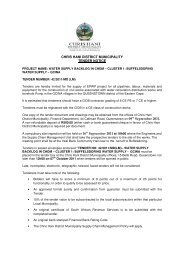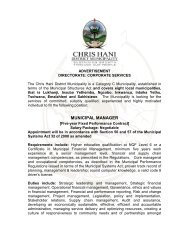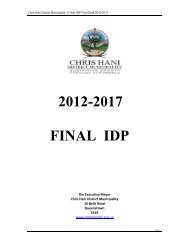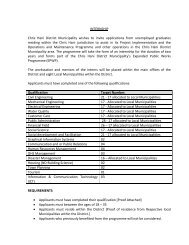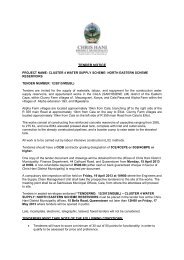- Page 1 and 2: AnnualReport for the financial year
- Page 3: ContentsPart 1Introduction And Over
- Page 6 and 7: Chapter 4: AUDITED STATEMENTS AND O
- Page 8 and 9: A : Foreword by ExecutiveMayorCHRIS
- Page 12 and 13: CHRIS HANI DISTRICT MUNICIPALITY AN
- Page 14 and 15: D : Executive SummaryThe annual rep
- Page 16 and 17: • Regional Bulk Infrastructure Gr
- Page 19 and 20: Chapter 1
- Page 21 and 22: POSITIONS PER DIRECTORATE FOR THE Y
- Page 23 and 24: CHDM WORKFORCE PROFILE INCLUDING PE
- Page 25 and 26: INTERNSHIPS EPWPAs part of the EPWP
- Page 27 and 28: Full staff complement per occupatio
- Page 29: 1.4 Remuneration of Top ManagersSen
- Page 32 and 33: Basic Service Delivery Performance
- Page 34 and 35: 2.1.d Major challenges in water ser
- Page 36 and 37: CHRIS HANI DISTRICT MUNICIPALITY AN
- Page 38 and 39: CHRIS HANI DISTRICT MUNICIPALITY AN
- Page 40 and 41: oooThe National Spatial Development
- Page 42 and 43: The Land Reform ABP Vision is:A tra
- Page 44 and 45: 2.6 OVERALL SERVICE DELIVERY BACKLO
- Page 46 and 47: CHRIS HANI DISTRICT MUNICIPALITY AN
- Page 48 and 49: CHRIS HANI DISTRICT MUNICIPALITY AN
- Page 50 and 51: CHRIS HANI DISTRICT MUNICIPALITY AN
- Page 52 and 53: PriorityAreaCHRIS HANI DISTRICT MUN
- Page 54 and 55: CHRIS HANI DISTRICT MUNICIPALITY AN
- Page 56 and 57: CHRIS HANI DISTRICT MUNICIPALITY AN
- Page 58 and 59: CHRIS HANI DISTRICT MUNICIPALITY AN
- Page 60 and 61:
CHRIS HANI DISTRICT MUNICIPALITY AN
- Page 62 and 63:
CHRIS HANI DISTRICT MUNICIPALITY AN
- Page 64 and 65:
CHRIS HANI DISTRICT MUNICIPALITY AN
- Page 66 and 67:
CHRIS HANI DISTRICT MUNICIPALITY AN
- Page 68 and 69:
CHRIS HANI DISTRICT MUNICIPALITY AN
- Page 70 and 71:
CHRIS HANI DISTRICT MUNICIPALITY AN
- Page 72 and 73:
CHRIS HANI DISTRICT MUNICIPALITY AN
- Page 74 and 75:
CHRIS HANI DISTRICT MUNICIPALITY AN
- Page 76 and 77:
CHRIS HANI DISTRICT MUNICIPALITY AN
- Page 78 and 79:
CHRIS HANI DISTRICT MUNICIPALITY AN
- Page 80 and 81:
CHRIS HANI DISTRICT MUNICIPALITY AN
- Page 82 and 83:
CHRIS HANI DISTRICT MUNICIPALITY AN
- Page 84 and 85:
CHRIS HANI DISTRICT MUNICIPALITY AN
- Page 86 and 87:
Municipal Local Economic Developmen
- Page 88 and 89:
CHRIS HANI DM REGIONAL ECONOMIC DEV
- Page 90 and 91:
3.2 PROGRESS TOWARDS ACHIEVING THE
- Page 92 and 93:
3.3 ANNUAL PERFORMANCE AS PER KEY P
- Page 94 and 95:
CHRIS HANI DISTRICT MUNICIPALITY AN
- Page 96 and 97:
4.1 Audited Financial statements 20
- Page 98 and 99:
3. OPERATING RESULTSDetails of the
- Page 100 and 101:
4. FINANCING OF CAPITAL EXPENDITURE
- Page 102 and 103:
4 521 682 -Details of the operating
- Page 104 and 105:
Refer to Note 19 for more detail.10
- Page 106 and 107:
CHRIS HANI DISTRICT MUNICIPALITYSTA
- Page 108 and 109:
742 042 289 810 241 213 Total Reven
- Page 110 and 111:
CHRIS HANI DISTRICT MUNICIPALITYCAS
- Page 112 and 113:
CHRIS HANI DISTRICT MUNICIPALITYNOT
- Page 114 and 115:
CHRIS HANI DISTRICT MUNICIPALITYNOT
- Page 116 and 117:
CHRIS HANI DISTRICT MUNICIPALITYNOT
- Page 118 and 119:
5. TRADE RECEIVABLES FROM NON-EXCHA
- Page 120 and 121:
Less: Provision forImpairment- - -
- Page 122 and 123:
Gross Balances - - - 146 486 146 48
- Page 124 and 125:
VAT is paid over to SARS.No interes
- Page 126 and 127:
CHRIS HANI DISTRICT MUNICIPALITY AN
- Page 128 and 129:
CHRIS HANI DISTRICT MUNICIPALITY AN
- Page 130 and 131:
CHRIS HANI DISTRICT MUNICIPALITY AN
- Page 132 and 133:
Other Assets: Motor Vehicles - 202
- Page 134 and 135:
10.2 Intangible Assets with Indefin
- Page 136 and 137:
14. CREDITORS2012 2011RRCHRIS HANI
- Page 138 and 139:
See Note 21 for the reconciliation
- Page 140 and 141:
17.1 Summary of ArrangementsThe Ann
- Page 142 and 143:
Movements in the present value of t
- Page 144 and 145:
The movement in Non-current Provisi
- Page 146 and 147:
The history of experienced adjustme
- Page 148 and 149:
21.2 Provincial: Health Subsidies20
- Page 150 and 151:
21.8 National - Department Public W
- Page 152 and 153:
21.14 Provincial: Department Housin
- Page 154 and 155:
23. SERVICE CHARGES2012 2011RRAvail
- Page 156 and 157:
26. OTHER REVENUE2012 2011RRCHRIS H
- Page 158 and 159:
Remuneration of Section 57 Employee
- Page 160 and 161:
Remuneration of the Director: Techn
- Page 162 and 163:
30.2 Impairment Losses on Financial
- Page 164 and 165:
Contracted Services have been resta
- Page 166 and 167:
2012 2011RRAttributable to: 28 331
- Page 168 and 169:
36.3 Analysis of Surplus / (Deficit
- Page 170 and 171:
The effect of the Changes and Corre
- Page 172 and 173:
The effect of the Correction of Err
- Page 174 and 175:
38.4 Reclassification of RevenueGov
- Page 176 and 177:
2012 2011RRDepreciation and Amortis
- Page 178 and 179:
2012 2011RRRepairs &MaintenanceInte
- Page 180 and 181:
40. CASH GENERATED BY OPERATIONS201
- Page 182 and 183:
2012 2011RRCHRIS HANI DISTRICT MUNI
- Page 184 and 185:
45.2 Audit Fees2012 2011RROpening B
- Page 186 and 187:
Supplier and owner of the Security
- Page 188 and 189:
Only one service provider respondin
- Page 190 and 191:
The only venue having facilities ne
- Page 192 and 193:
Elimination: Cluster 5, which will
- Page 194 and 195:
SUMMARY OF FINANCIAL ASSETS2012 201
- Page 196 and 197:
SUMMARY OF FINANCIAL LIABILITIES201
- Page 198 and 199:
Level 2:-Fair Values are calculated
- Page 200 and 201:
Debt is defined as Long- and Short-
- Page 202 and 203:
47.6 Market RiskThe municipality’
- Page 204 and 205:
The municipality limits its counter
- Page 206 and 207:
Total Bank and Cash Balances 298 15
- Page 208 and 209:
CHRIS HANI DISTRICT MUNICIPALITY AN
- Page 210 and 211:
CHRIS HANI DISTRICT MUNICIPALITYNOT
- Page 212 and 213:
DEFINED CONTRIBUTION SCHEMESCape Jo
- Page 214 and 215:
CHRIS HANI DISTRICT MUNICIPALITY AN
- Page 216 and 217:
49.5 Purchases from Related Parties
- Page 218 and 219:
eceived and the municipality’s at
- Page 220 and 221:
57. COMPARISON WITH THE BUDGETBudge
- Page 222 and 223:
CHRIS HANI DISTRICT MUNICIPALITY AN
- Page 224 and 225:
CHRIS HANI DISTRICT MUNICIPALITY AN
- Page 226 and 227:
CHRIS HANI DISTRICT MUNICIPALITY AN
- Page 228 and 229:
CHRIS HANI DISTRICT MUNICIPALITY AN
- Page 230 and 231:
CHRIS HANI DISTRICT MUNICIPALITY AN
- Page 232 and 233:
CHRIS HANI DISTRICT MUNICIPALITY AN
- Page 234 and 235:
CHRIS HANI DISTRICT MUNICIPALITY AN
- Page 236 and 237:
GENERAL INFORMATIONEXECUTIVE MAYORM
- Page 238 and 239:
APPROVAL OF FINANCIAL STATEMENTSI a
- Page 240 and 241:
CERTIFICATION OF REMUNERATION OF CO
- Page 242 and 243:
1. BASIS OF PRESENTATION (continued
- Page 244 and 245:
1. BASIS OF PRESENTATION (continued
- Page 246 and 247:
1. BASIS OF PRESENTATION (continued
- Page 248 and 249:
2.ACCUMULATED SURPLUSIncluded in th
- Page 250 and 251:
3.1.1PROPERTY, PLANT AND EQUIPMENTI
- Page 252 and 253:
3. PROPERTY, PLANT AND EQUIPMENT (c
- Page 254 and 255:
4. INTANGIBLE ASSETS (continued)4.1
- Page 256 and 257:
5.IMPAIRMENT OF ASSETSThe municipal
- Page 258 and 259:
6.FINANCIAL INSTRUMENTSThe municipa
- Page 260 and 261:
6. FINANCIAL INSTRUMENTS (continued
- Page 262 and 263:
6. FINANCIAL INSTRUMENTS (continued
- Page 264 and 265:
7.1.1INVENTORIESInitial Recognition
- Page 266 and 267:
8. NON-CURRENT ASSETS HELD-FOR-SALE
- Page 268 and 269:
9. REVENUE RECOGNITION (continued)9
- Page 270 and 271:
9. REVENUE RECOGNITION (continued)9
- Page 272 and 273:
10.PROVISIONSProvisions are recogni
- Page 274 and 275:
11. EMPLOYEE BENEFITS (continued)11
- Page 276 and 277:
12.LEASES1.1 ClassificationLeases a
- Page 278 and 279:
17.FRUITLESS AND WASTEFUL EXPENDITU
- Page 280 and 281:
22.RELATED PARTIESIndividuals as we
- Page 282 and 283:
CHRIS HANI DISTRICT MUNICIPALITY AN
- Page 284 and 285:
CHRIS HANI DISTRICT MUNICIPALITY AN
- Page 286 and 287:
CHRIS HANI DISTRICT MUNICIPALITY AN
- Page 288 and 289:
CHRIS HANI DISTRICT MUNICIPALITY AN
- Page 290 and 291:
CHRIS HANI DISTRICT MUNICIPALITY AN
- Page 292 and 293:
CHRIS HANI DISTRICT MUNICIPALITY AN
- Page 294 and 295:
CHRIS HANI DISTRICT MUNICIPALITY AN
- Page 296 and 297:
CHRIS HANI DISTRICT MUNICIPALITY AN
- Page 298 and 299:
CHRIS HANI DISTRICT MUNICIPALITY AN
- Page 300 and 301:
CHRIS HANI DISTRICT MUNICIPALITY AN
- Page 302 and 303:
IDPObjecttiveExpenditureManagementS
- Page 304 and 305:
RevenuemanagementTo ensureproperrev
- Page 306 and 307:
To ensureautomationofbusinessproces
- Page 308 and 309:
AnnualFinancialStatements&RelatedRe
- Page 310 and 311:
Paymentof Serviceprovidersas perSCM
- Page 312 and 313:
4.5 The Auditor General ReportCHRIS
- Page 314 and 315:
CHRIS HANI DISTRICT MUNICIPALITY AN
- Page 316 and 317:
CHRIS HANI DISTRICT MUNICIPALITY AN
- Page 318 and 319:
CHRIS HANI DISTRICT MUNICIPALITY AN
- Page 320 and 321:
CHRIS HANI DISTRICT MUNICIPALITY AN
- Page 322 and 323:
CHRIS HANI DISTRICT MUNICIPALITY AN
- Page 324 and 325:
CHRIS HANI DISTRICT MUNICIPALITY AN
- Page 326 and 327:
CHRIS HANI DISTRICT MUNICIPALITY AN
- Page 328 and 329:
CHRIS HANI DISTRICT MUNICIPALITY AN
- Page 330 and 331:
CHRIS HANI DISTRICT MUNICIPALITY AN
- Page 332 and 333:
CHRIS HANI DISTRICT MUNICIPALITY AN
- Page 334 and 335:
CHRIS HANI DISTRICT MUNICIPALITY AN
- Page 336 and 337:
CHRIS HANI DISTRICT MUNICIPALITY AN
- Page 338 and 339:
CHRIS HANI DISTRICT MUNICIPALITY AN
- Page 340 and 341:
CHRIS HANI DISTRICT MUNICIPALITY AN
- Page 343 and 344:
Good governance and Public Particip
- Page 345 and 346:
In the financial year 2011 - 12 var
- Page 347 and 348:
For the period under review, the DI
- Page 349 and 350:
ProfessionalbodyMatter Code Matter
- Page 351 and 352:
Part 02Part 2 :Functional Area repo
- Page 353 and 354:
Function: Community and Health Serv
- Page 355 and 356:
Disposal Of the Dead- Controlling,r
- Page 357 and 358:
Key Performance AreaPerformance Dur
- Page 359 and 360:
However, due to the challenges face
- Page 361 and 362:
Contract Description Name of Contra
- Page 363 and 364:
Contract Description Name of Contra
- Page 365 and 366:
Part 02Annexures361
- Page 367 and 368:
MUNICIPAL MANAGER’S OFFICEINTERNA
- Page 369 and 370:
STRATEGIC MANAGEMENT OFFICEEXECUTIV
- Page 371 and 372:
Summary: Corporate ServicesNew Posi
- Page 373 and 374:
CORPORATE SERVICESHUMAN RESOURCES M
- Page 375 and 376:
CORPORATE SERVICESFLEET MANAGEMENT
- Page 377 and 378:
Summary: Budget & TreasuryNew Posit
- Page 379 and 380:
BUDGET & TREASURYTREASURY MANAGEMEN
- Page 381 and 382:
Supply Chain ManagementAnnexure 4.4
- Page 383 and 384:
Summary: IPEDNew PositionVacantOccu
- Page 385 and 386:
Town PlannerPL 05INTEGRATED PLANNIN
- Page 387 and 388:
HEALTH AND COMMUNITY SERVICES OFFIC
- Page 389 and 390:
6 X EHP’sPL 06 DoH Structure supp
- Page 391 and 392:
Manager: WaterService ProviderPL 03
- Page 393 and 394:
ENGINEERING DIRECTORATEROADS SECTIO
- Page 395 and 396:
ENGINEERING DIRECTORATEWater Servic
- Page 397 and 398:
ENGINEERING DIRECTORATEWater Servic
- Page 399 and 400:
ENGINEERING DIRECTORATEWater Servic
- Page 401 and 402:
CleanerENGINEERING DIRECTORATEWater
- Page 403 and 404:
ENGINEERING DIRECTORATEWater Servic






